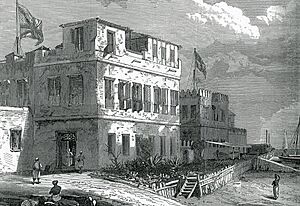Atkins Hamerton facts for kids
Quick facts for kids
Atkins Hamerton
|
|
|---|---|
| Born | 1804 Donnycarney, County Dublin, Ireland |
| Died | 1857 Zanzibar |
| Allegiance | |
| Service/ |
|
| Rank | Captain |
Atkins Hamerton (1804 – 5 July 1857) was a British soldier and diplomat. He worked as the first British consul in Zanzibar from 1841 to 1857. He is known for trying to stop the Arab slave trade between Zanzibar and the Persian Gulf. This was a very difficult task.
Contents
Who Was Atkins Hamerton?
Atkins Hamerton was born in 1804 in Donnycarney, County Dublin, Ireland. His father, Edward Hamerton, worked as a clerk in Dublin. Atkins went to school at St Thomas's Church in Dublin.
A Soldier's Journey
In 1825, Hamerton traveled to Bombay, India. He joined the British Indian Army. This was the army of British India. He rose through the ranks and became a Captain in 1837. He served in the 15th Regiment Bombay Native Infantry.
In 1840, Captain Hamerton went on an important mission. He visited the oasis city of Al-Buraimi in Oman. His job was to give advice on how to make its defenses stronger. He was one of the first Europeans to visit this city. He was also only the second European to travel through the northern parts of Oman.
Working as a British Consul
Hamerton was first sent by the Honourable East India Company to Muscat. This company managed British trade in India and Asia. The next year, he moved to Zanzibar. His job was to look after the Company's business there.
The East India Company and the British Foreign Office agreed on a new role for him. He became the first British consul in Zanzibar. A consul is like a representative from one country living in another. His instructions were to gather information about the French presence. He also had to report on the slave trade to London and the British Government in Bombay.
Fighting the Slave Trade
Hamerton became good friends with Said bin Sultan. Said was the ruler of the Omani Empire at that time. The sultan even let Hamerton live in a building by the sea for free. The British government wanted to use this friendship. They hoped to end the slave trade in Zanzibar. This trade was very active then.
Lord Palmerston, who was the foreign secretary in Britain, strongly opposed the slave trade. He told Hamerton that Britain was determined to stop it. He asked Hamerton to tell Said bin Sultan that the trade must end.
Zanzibar was under the East India Company's control. So, the British Governor General in India had more power than the foreign secretary in London. In the past, the Company had not done much about the African slave trade. But Palmerston's letter changed things. In 1843, Hamerton was told to talk to Said about ending the trade.
Said bin Sultan explained that slavery was allowed by Islam. He said the Koran, which is their holy book, permitted it. He believed Arabs had a right to enslave non-believers.
However, Hamerton was a skilled negotiator. In 1845, Said signed a treaty. It became known as the "Hamerton treaty." This treaty made it illegal to send slaves from Zanzibar to the Persian Gulf area. Even though Lord Aberdeen and the Foreign Office did most of the work, Hamerton helped make it happen.
But the treaty did not stop the slave trade completely. The Company did not enforce it well. Britain also had few warships in the area. So, the slave trade continued. Hamerton estimated that three-quarters of Zanzibar's people were slaves.
Helping Famous Explorers
In 1856, two famous explorers, Richard Burton and John Hanning Speke, stayed at Hamerton's house. They were preparing for a journey to the Great Lakes of Africa. They wanted to find the source of the Nile River. Hamerton helped them a lot. He got along very well with Burton. He found Speke to be more quiet.
His Final Years
Atkins Hamerton died at age fifty-three in 1857. He passed away from liver disease. Some people said his illness was more than just physical. They believed he was unwilling to leave the place that was slowly harming him. Burton had noted that Hamerton's hair was "prematurely snow-white" the year before he died.
Years after Hamerton's death, another famous explorer's body was brought to his former home. This was David Livingstone. His body was on its way back to Britain.


